Related Research Articles

The Norfolk Southern Railway is a Class I freight railroad operating in the Eastern United States. Headquartered in Atlanta, the company was formed in 1982 with the merger of the Norfolk and Western Railway and Southern Railway. The company operates 19,420 route miles (31,250 km) in 22 eastern states, the District of Columbia, and has rights in Canada over the Albany to Montreal route of the Canadian Pacific Kansas City. Norfolk Southern Railway is the leading subsidiary of the Norfolk Southern Corporation.

The Virginian Railway was a Class I railroad located in Virginia and West Virginia in the United States. The VGN was created to transport high quality "smokeless" bituminous coal from southern West Virginia to port at Hampton Roads.

The Norfolk and Western Railway, commonly called the N&W, was a US class I railroad, formed by more than 200 railroad mergers between 1838 and 1982. It was headquartered in Roanoke, Virginia, for most of its existence. Its motto was "Precision Transportation"; it had a variety of nicknames, including "King Coal" and "British Railway of America". In 1986, N&W merged with Southern Railway to form today's Norfolk Southern Railway.
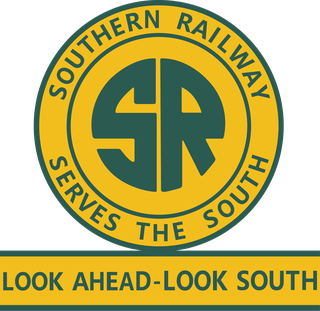
The Southern Railway was a class 1 railroad based in the Southern United States between 1894 and 1982, when it merged with the Norfolk and Western Railway (N&W) to form the Norfolk Southern Railway. The railroad was the product of nearly 150 predecessor lines that were combined, reorganized and recombined beginning in the 1830s, formally becoming the Southern Railway in 1894.

The Seaboard Air Line Railroad, which styled itself as "The Route of Courteous Service", was an American railroad that existed from April 14, 1900, until July 1, 1967, when it merged with the Atlantic Coast Line Railroad, its longtime rival, to form the Seaboard Coast Line Railroad. Predecessor railroads dated from the 1830s and reorganized extensively to rebuild after the American Civil War. The company was headquartered in Norfolk, Virginia, until 1958, when its main offices were relocated to Richmond, Virginia. The Seaboard Air Line Railway Building in Norfolk's historic Freemason District still stands and has been converted into apartments.

Southern Railway 4501 is a preserved Ms class 2-8-2 "Mikado" type steam locomotive built in October 1911 by the Baldwin Locomotive Works in Philadelphia, Pennsylvania, as the first of its wheel arrangement type for the Southern Railway (SOU). In 1948, the locomotive was retired from the SOU in favor of dieselization and was sold to the shortline Kentucky and Tennessee Railway (K&T) in Stearns, Kentucky, to haul coal trains.

The Powhatan Arrow was a named luxurious passenger train, operated by the Norfolk and Western Railway (N&W) in the United States. It made its inaugural operation on April 28, 1946, and proclaimed as one of America's first new postwar streamliners, despite not having new equipment. The Powhatan Arrow had two trains; Nos. 25 and 26, which both ran 676 miles (1,088 km) daily at daylight on the N&W mainline between Norfolk, Virginia, and Cincinnati, Ohio in opposite directions. It takes about 15 hours and 45 minutes for both trains to run per day. They were hauled behind N&W's streamlined 4-8-4 class J steam locomotives.

The Norfolk and Western J class was a class of fourteen 4-8-4 "Northern" streamlined steam locomotives built by the Norfolk and Western Railway (N&W) at its Roanoke Shops in Roanoke, Virginia, between 1941 and 1950. They were the most powerful 4-8-4 steam locomotives ever produced. The class Js, along with class A and Y6 freight locomotives were the N&W's "Big Three" representing the pinnacles of steam technology.
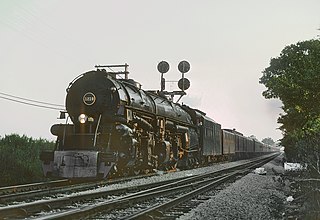
Norfolk and Western 1218 is a preserved four-cylinder simple articulated 2-6-6-4 steam locomotive, built in June 1943 by the Norfolk and Western's (N&W) Roanoke Shops in Roanoke, Virginia as part of the N&W's class "A" fleet of fast freight locomotives. It was retired from regular revenue service in July 1959, and was later restored by Norfolk Southern for excursion service for their steam program, pulling excursions throughout the eastern United States from 1987 to 1991. It is currently on display at the Virginia Museum of Transportation in Roanoke, Virginia.
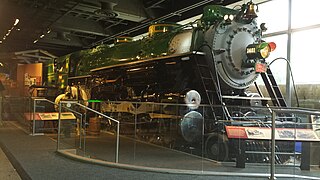
Southern Railway 1401 is a 4-6-2 steam locomotive built in July 1926 by the American Locomotive Company (ALCO) of Richmond, Virginia for the Southern Railway (SOU) as a member of the Ps-4 class, which was based on the United States Railroad Administration (USRA) Heavy Pacific design with some minor differences. It was assigned to haul the SOU's Crescent Limited passenger train between Washington, D.C., and Atlanta, Georgia.
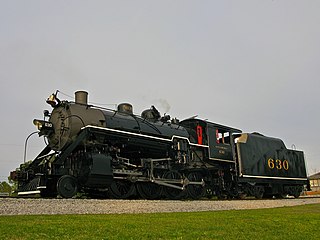
Southern Railway 630 is a 2-8-0 "Consolidation" type steam locomotive built in February 1904 by the American Locomotive Company (ALCO) of Richmond, Virginia for the Southern Railway as a member of the Ks-1 class. It is currently owned and operated by the Tennessee Valley Railroad Museum (TVRM) in Chattanooga, Tennessee where it resides today for use on excursion trains.

Southern Railway 722 is a class "Ks-1" 2-8-0 "Consolidation" type steam locomotive built in September 1904 by the Baldwin Locomotive Works to run on the Murphy Branch, where it hauled freight trains between Asheville and Murphy, North Carolina for the Southern Railway (SOU). In 1952, it was purchased by the East Tennessee and Western North Carolina Railroad (ET&WNC), alongside its sister locomotive No. 630, where they were served as switchers around Johnson City and Elizabethton, Tennessee.
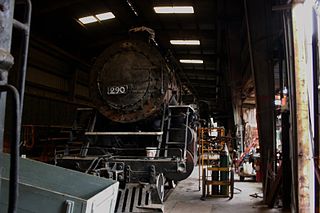
Atlanta and West Point 290 is a P-74 steam locomotive built in March 1926 by the Lima Locomotive Works (LLW) in Lima, Ohio for the Atlanta and West Point Railroad. It is a 4-6-2 heavy "Pacific" type steam locomotive, which was remarkably similar to the Southern Railway's Ps-4 class. With sister locomotive No. 190 built for the Western Railway of Alabama (WRA), No. 290 ferried the Southern Railway's Crescent passenger train from Atlanta, Georgia to Montgomery, Alabama until its retirement from revenue service in 1954.

Norfolk and Western 611, also known as the "Spirit of Roanoke" and the "Queen of Steam", is the only surviving example of Norfolk and Western's (N&W) class J 4-8-4 type "Northern" streamlined steam locomotives. Built in May 1950 at N&W's Roanoke Shops in Roanoke, Virginia, it was one of the last mainline passenger steam locomotives built in the United States and represents one of the pinnacles of American steam locomotive technology.
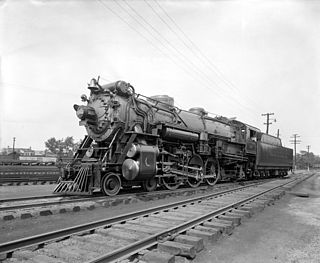
The Southern Railway Ps-4 was a class of 4-6-2 steam locomotives built for the Southern Railway, as well as its subsidiaries, the Alabama Great Southern Railroad and the Cincinnati, New Orleans and Texas Pacific Railway. The locomotives were notable for their green with gold trim liveries, and have been regarded by Smithsonian curator John H. White Jr. as being "among the most celebrated passenger locomotives operated in the United States...."

Tennessee Valley Railroad No. 610 is a preserved S160 Class 2-8-0 "Consolidation" type steam locomotive built by the Baldwin-Lima-Hamilton Corporation for the U.S. Army in March 1952. It is one of the last steam locomotives built for service in the United States and the last new steam locomotive acquired by the U.S. Army. As of 2023, No. 610 is owned by the Tennessee Valley Railroad Museum.
The 21st Century Steam program was conducted by the Norfolk Southern Railway from 2011 to 2015, featuring four classic steam locomotives pulling passenger excursions along Norfolk Southern rails in the eastern United States. The last train was to be Southern 4501's Piedmont Limited excursion trip from Atlanta, Georgia, to Toccoa, Georgia, but cancelled on October 1 due to Hurricane Joaquin.

Chesapeake and Ohio Railway 2716 is a class "K-4" 2-8-4 "Kanawha" (Berkshire) type steam locomotive built in 1943 by the American Locomotive Company (ALCO) for the Chesapeake and Ohio Railway (C&O). While most railroads referred to these 2-8-4 type locomotives as Berkshires, the C&O referred to them as Kanawhas after the Kanawha River, which flows through West Virginia. Used as a dual service locomotive, No. 2716 and its classmates served the C&O in a variety of duties until being retired from revenue service in 1956.

Savannah and Atlanta 750, formerly Florida East Coast 80, is a 4-6-2 “Light Pacific” steam locomotive built in January 1910 by the American Locomotive Company (ALCO) of Schenectady, New York, originally for the Florida East Coast Railway (FEC) as No. 80. Throughout the 1930s, FEC had sold of several of their locomotives, with No. 80 being sold in 1935 to the Savannah and Atlanta Railway, where it was renumbered to 750. The locomotive pulled commuter passenger trains and occasional mixed freight trains for the S&A, until the railroad dieselized in the early 1950s. In 1962, the locomotive was donated to the Atlanta Chapter of the National Railway Historical Society, who began using the locomotive to pull occasional excursion trains. No. 750 was subsequently leased to the Southern Railway for use to pull trains for their new steam excursion program, and the lease ended in 1984. From 1985 to 1989, the locomotive pulled excursion trains for the New Georgia Railroad around Atlanta, until it was retired, due to firebox issues. As of 2022, No. 750 remains on static display inside the Southeastern Railway Museum in Duluth, Georgia.

The Cedar train wreck occurred on the night of January 23, 1956, when the Norfolk and Western (N&W) Pocahontas passenger train derailed at more than 50 mph (80 km/h) along the Tug River near Cedar, West Virginia. The accident killed the engineer and injured 51 passengers and nine crew members. It was the last major wreck of a steam-powered revenue passenger train in the United States.
References
- ↑ David R. Goode 1941— Biography - Trains as accountant and lawyer Retrieved 2018-05-11.
- ↑ Virginia House of Delegates. "House Joint Resolution No. 930". February 24, 2005. Retrieved on May 16, 2013.
- ↑ Norfolk Southern Corporation. "Norfolk Southern Names Atlanta Building for David R. Goode" (Press Release). September 27, 2005. Retrieved on May 16, 2013.
- ↑ Wrinn (2000) , p. 102.
- ↑ Wrinn (2000) , p. 107.
- ↑ Hensley & Miller (2021) , p. 103.
- ↑ Buteau, Michael; Paskin, Janet (August 10, 2015). "118 Rich and Powerful People Who Are Members of Augusta National". Bloomberg. Retrieved February 21, 2021.